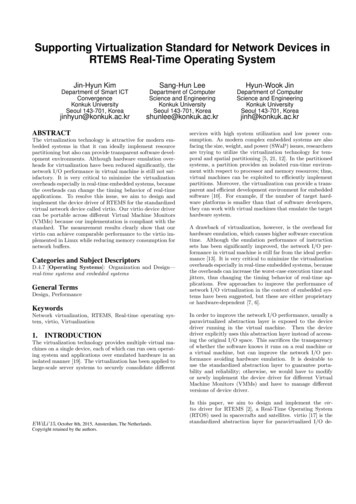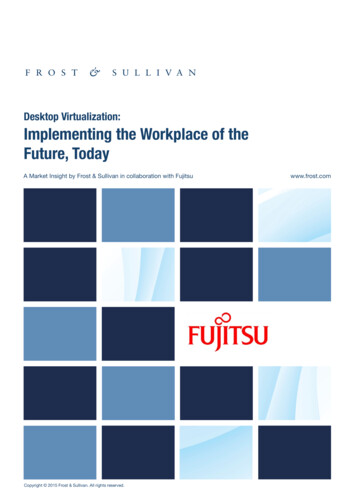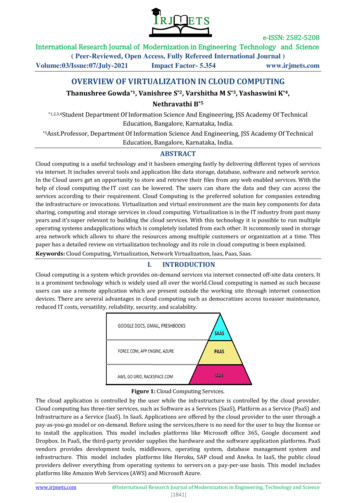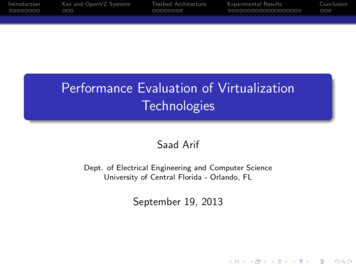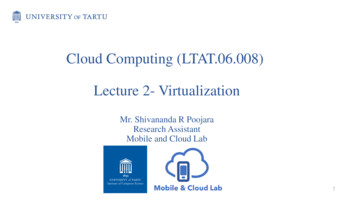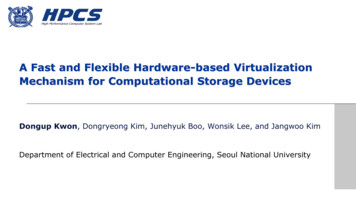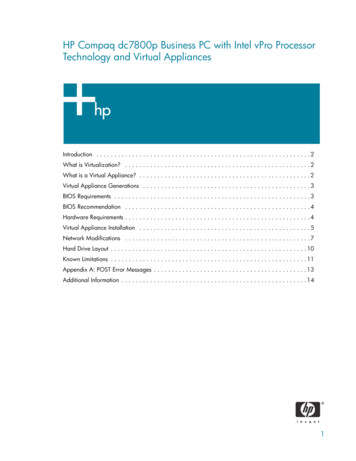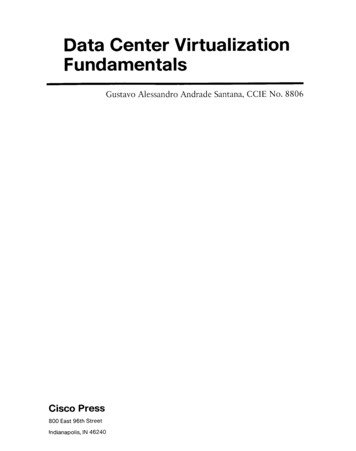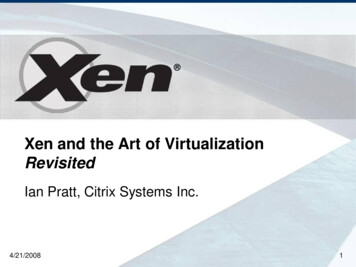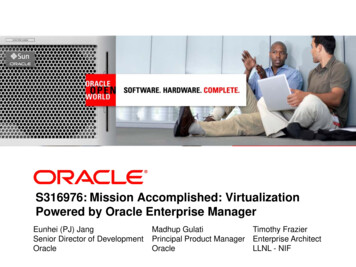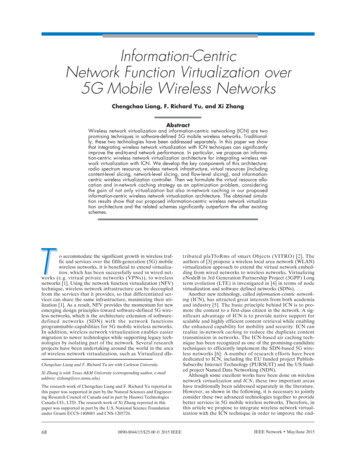
Transcription
ZHANG LAYOUT Layout 1 5/15/15 12:58 PM Page 68Information-CentricNetwork Function Virtualization over5G Mobile Wireless NetworksChengchao Liang, F. Richard Yu, and Xi ZhangAbstractWireless network virtualization and information-centric networking (ICN) are twopromising techniques in software-defined 5G mobile wireless networks. Traditionally, these two technologies have been addressed separately. In this paper we showthat integrating wireless network virtualization with ICN techniques can significantlyimprove the end-to-end network performance. In particular, we propose an information-centric wireless network virtualization architecture for integrating wireless network virtualization with ICN. We develop the key components of this architecture:radio spectrum resource, wireless network infrastructure, virtual resources (includingcontent-level slicing, network-level slicing, and flow-level slicing), and informationcentric wireless virtualization controller. Then we formulate the virtual resource allocation and in-network caching strategy as an optimization problem, consideringthe gain of not only virtualization but also in-network caching in our proposedinformation-centric wireless network virtualization architecture. The obtained simulation results show that our proposed information-centric wireless network virtualization architecture and the related schemes significantly outperform the other existingschemes.To accommodate the significant growth in wireless traffic and services over the fifth-generation (5G) mobilewireless networks, it is beneficial to extend virtualization, which has been successfully used in wired networks (e.g. virtual private networks (VPNs)), to wirelessnetworks [1]. Using the network function virtualization (NFV)technique, wireless network infrastructure can be decoupledfrom the services that it provides, so that differentiated services can share the same infrastructure, maximizing their utilization [1]. As a result, NFV provides the momentum for newemerging design principles toward software-defined 5G wireless networks, which is the architecture extension of softwaredefined networks (SDN) with the network functionsprogrammable-capabilities for 5G mobile wireless networks.In addition, wireless network virtualization enables easiermigration to newer technologies while supporting legacy technologies by isolating part of the network. Several researchprojects have been undertaking around the world in the areaof wireless network virtualization, such as Virtualized dIsChengchao Liang and F. Richard Yu are with Carleton University.Xi Zhang is with Texas A&M University (corresponding author, e-mailaddress: xizhang@ece.tamu.edu).The research work of Chengchao Liang and F. Richard Yu reported inthis paper was supported in part by the Natural Sciences and Engineering Research Council of Canada and in part by Huawei TechnologiesCanada CO., LTD. The research work of Xi Zhang reported in thispaper was supported in part by the U.S. National Science Foundationunder Grants ECCS-1408601 and CNS-1205726.680890-8044/15/ 25.00 2015 IEEEtributed plaTfoRms of smart Objects (VITRO) [2]. Theauthors of [3] propose a wireless local area network (WLAN)virtualization approach to extend the virtual network embedding from wired networks to wireless networks. VirtualizingeNodeB in 3rd Generation Partnership Project (3GPP) Longterm evolution (LTE) is investigated in [4] in terms of nodevirtualization and software defined networks (SDNs).Another new technology, called information-centric networking (ICN), has attracted great interests from both academiaand industry [5]. The basic principle behind ICN is to promote the content to a first-class citizen in the network. A significant advantage of ICN is to provide native support forscalable and highly efficient content retrieval while enablingthe enhanced capability for mobility and security. ICN canrealize in-network caching to reduce the duplicate contenttransmission in networks. The ICN-based air caching technique has been recognized as one of the promising-candidatetechniques to efficiently implement the SDN-based 5G wireless networks [6]. A number of research efforts have beendedicated to ICN, including the EU funded project PublishSubscribe Internet Technology (PURSUIT) and the US funded project Named Data Networking (NDN).Although some excellent works have been done on wirelessnetwork virtualization and ICN, these two important areashave traditionally been addressed separately in the literature.However, as shown in the following, it is necessary to jointlyconsider these two advanced technologies together to providebetter services in 5G mobile wireless networks. Therefore, inthis article we propose to integrate wireless network virtualization with the ICN technique in order to improve the end-IEEE Network May/June 2015
ZHANG LAYOUT Layout 1 5/15/15 12:58 PM Page 69SPSPSPSPSPSP(MVNO)(MVNO)(MVNO)to-end network performance. The motivationsbehind our work are based on the followingobservations: On one hand, wireless network virtualizationenables the sharing of not only the infrastructure,MVNOMVNObut also the content, among different serviceproviders. Consequently, the capital expenses(CapEx) and operation expenses (OpEx) of content delivery, wireless access networks, as well ascore networks, can be significantly reduced.MNOMNOInPInP On the other hand, virtual resource allocation (e.g. which nodes, links, and resources shouldbe selected and optimized) is a significant chal(a)(b)lenge of wireless network virtualization. As content retrieval (instead of other traditionalFigure 1. Business models of wireless network virtualization: a) A two-levelparameters, such as spectrum efficiency) is givenmodel; b) A three-level model, where SP — service provider; MNO —a high priority in ICN, the processes in wirelessmobile network operator; MVNO — mobile virtual network operator; InPnetwork virtualization (e.g. virtual resource— infrastructure provider.abstracting, slicing, sharing, and control) will besignificantly affected by ICN. Therefore, integrating wireless network virtualization with the ICN technique can significantly improve theworks consist of licensed spectrum resource and infrastructureend-to-end network performance and maximize the utilityresources, including radio access networks (RANs), core netfunction and efficiency of virtual mobile wireless networkworks (CNs), and transport networks.operations.As shown in Fig. 1a, two logical roles can be identifiedThe major contributions of this article are as follows:after virtualization: mobile network operator (MNO) and ser We propose an information-centric wireless network virtuvice provider (SP). MNOs own and operate infrastructures andalization architecture that can enable both wireless networkradio resources of physical substrate wireless networks, includvirtualization and ICN in 5G mobile wireless networks.ing licensed spectrum, RANs, backhaul, transmission net We define and develop the key components of this archiworks, and CNs. MNOs implement the virtualization, andtecture: radio spectrum resource, wireless network infrastrucslice the physical mobile network resources into virtual mobileture, virtual resources (including content-level slicing,network resources. For brevity, we use virtual resources tonetwork-level slicing, and flow-level slicing), and an informaindicate the virtual mobile network resources. SPs lease, opertion-centric wireless virtualization controller.ate, and program these virtual resources to offer end-to-end We formulate the virtual resource allocation and in-netservices to mobile users.work caching strategies as a joint optimization problem, takThe roles in the business model can be further decoupleding into account the gains of not only virtualization but alsointo more specialized roles, including SP, infrastructurein-network caching in the proposed information-centric wireprovider (InP), and mobile virtual network operator (MVNO) [7],less network virtualization architecture. Simulation results areas shown in Fig. 1b. Their functions in this model are detailedpresented to validate and evaluate the performance of ouras follows.proposed architecture and schemes.SP: Concentrates on providing services to its subscribersThe rest of this article is organized as follows. The followbased on the virtual resources provided by MVNOs.ing section introduces wireless network virtualization andInP: Owns the physical cellular network infrastructureinformation-centric networking. Then we propose the archiresources and physical radio resources. In some special cases,tecture of information-centric wireless network virtualization.the physical radio resources may not be owned by InPs.Following that we formulate the virtual resource allocationSpecifically, some wired network InPs who have no RAN andand in-network caching strategy. Then we evaluate our prolicensed spectrum can provide backhaul network service.posed scheme through simulations. The final section conMoreover, some companies (e.g. tower companies) who onlycludes this article and briefly discusses the future work.build BSs without providing services also do not have licensedspectrum.MVNO: Leases the network resources from InPs, createsvirtual resources based on the requests from SPs, operates theWireless Network Virtualization andvirtual resources, and assigns them to SPs. The emergence ofInformation-Centric NetworkingMVNOs breaks the value chain dominated by the traditionalMNOs [8]. Compared to MNOs, MVNOs do not own specIn this section we present the business models and logicaltrum and radio access networks [1]. Compared to the existingroles in wireless network virtualization, followed by the introMVNOs in Fig. 1a, MVNOs in Fig. 1b have more opportuniduction of the ICN technique.ties to access cellular networks including RANs through leasWireless Network Virtualizationing and operating mobile network resources from InPs, andthey can deploy and create more flexible virtual networks.With virtualization, physical cellular network infrastructureThe above business models can be summarized using theresources and physical radio resources can be abstracted andemerging concept of X-as-a-service (XaaS) in cloud computsliced into virtual cellular network resources holding certaining. Infrastructure-as-a-service (IaaS) is provided by InPs; netcorresponding functionalities, and shared by multiple partieswork-as-a-service (NaaS) is operated by MVNOs. Moreover,through isolating each other. In other words, virtualizingSPs can provide software-as-a-service (SaaS) (or cloud-as-amobile cellular networks is to realize the process of abstractservice (CaaS)).ing, slicing, isolating, and sharing mobile cellular networks.In commercial markets, CapEx and OpEx can be signifiGenerally speaking, the physical resources in cellular net-IEEE Network May/June 201569
ZHANG LAYOUT Layout 1 5/15/15 12:58 PM Page rSubsriberNetwork nodeContentadvertisementsContent from thepublisherContentSubscriptionsContent from thecacheFigure 2. The information-centric networking model.cantly reduced due to the sharing enabled by wireless networkvirtualization. The authors of [9] estimate that up to 40 percent of 60 billion used for OpEx and CapEx can be saved byoperators worldwide over a five-year period. Over the pastyears, MVNOs and over-the-top (OTT) SPs have becomestrong players in mobile network markets, and have broughttheir featured services to impact the ecotope of the traditionalmarket dominated by MNOs. The OTT SPs refer to thosewho provide audio, video, and other media applications overnetworks without the involvement of network operators in thecontrol or distribution of the content. Fortunately, wirelessnetwork virtualization brings a win-win situation for bothMVNOs and MNOs [10]. MVNOs or other types of SPs canlease virtual networks from MNOs, and MNOs can attract agreater number of customers from MVNOs and SPs. ForMNOs themselves, since the network can be isolated into several slices, any upgrading and maintenance in one slice willnot affect other running services. For SPs, leasing virtual networks helps them “get rid of” the control of MNOs, so thatthe customized and more flexible services can be providedmore easily, and quality of service (QoS) can be enhanced aswell. This also brings revenues to MNOs, because SPs need topay MNOs for the leased virtual networks.Information-Centric NetworkingFigure 2 shows the ICN model. As shown in Fig. 2, the communication paradigm within ICN is different from what it iswith the Internet Protocol (IP). Current IP architecturesrevolve around a host-based conversation model (i.e. a connection of communication is established between two hostsbefore any content is transferred), and the delivery of data inthe network follows a source-driven approach (i.e. the path isset up from the sender to the receiver). In contrast, the mainconcern of ICN is to disseminate, find, and deliver information rather than the reachability of end hosts and the maintenance of conversations between them. In ICN, the userrequests content without knowledge of the host that can provide it, and the communication follows a receiver-driven principle (i.e. the path is set up by the receiver to the provider),and the data follows the reverse path. The network is then incharge of doing the mapping between the requested contentand where it can be found (see Fig. 2). The match of requested content rather than the findability of the endpoint thatprovides it thus dictates the connection establishment in ICN.To be efficient, one key aspect of ICN is naming. Contentshould be named in such a way as to be independent of thelocation of the node where the content can be found, which is70the main objective of ICN (to separate naming and location).As shown in Fig. 2, ICN also includes a native caching function in the network, in such a way that nodes can cache thecontents passing through it for a while (depending on thecache size and replacement algorithm) and deliver them tothe requesting users. Via this in-network caching mechanism,the content is replicated, and the delivery probability of thiscontent to the end user is increased.Decoupling naming from location also allows native support of mobility or multicast in ICN. Indeed, when usersmove, they are connected to another node in the ICN network, but since no IP address is used for the routing, it istransparent, as opposed to IP, where the address should bechanged. For multicast, as soon as one user has requested agiven content, one node can cache it and then deliver it forsubsequent requests for the same content. It then naturallycreates a multicast-like content delivery.Another similar technique, which is called content deliverynetworking (CDN), tries to put the content near the customers. CDN is deployed as overlays at the application layer,while ICN applies the techniques at the lower layers (e.g. networking layer). Another difference is that CDN typicallyemploys network-unaware mechanisms. By contrast, efficientinformation retrieval can benefit from ICN that providesInternet-wide infrastructure supporting in-network mechanisms.Information-Centric Wireless NetworkVirtualizationIn this section we propose an architecture for enabling bothwireless network virtualization and ICN, which is called information-centric wireless network virtualization. We present themotivations, radio spectrum resource, mobile network infrastructure, virtual resources, and information-centric virtualization controller in this novel architecture.Motivations Behind Information-Centric Wireless NetworkVirtualizationTraditionally, dedicated physical resources from specific operators are used for content delivery. As these physical resourcescannot be shared by different operators, content deliveryincrease the complexity of the network, as well as the CapExand OpEx [11]. Moreover, content delivery is a very volatilemarket with new protocols, content formats, device types, andso on. With dedicated physical resources, operators do nothave the flexibility to react to these rapid changes. Fortunately, wireless network virtualization enables the sharing of notonly the infrastructure, but also the content, among differentservice providers. By introducing network virtualization intoICN, new networking technologies that are designed for ICNcan be deployed and implemented quickly without effectingtraditional networks. Furthermore, through the combinationof virtualization and ICN, not only the physical resources butalso the content can be shared. Since duplicative contenttransmissions consume physical resources (especially backhaulnetworks), sharing content among virtual networks can reducethe unnecessary duplicative transmissions. Consequently, theCapEx and OpEx of wireless access networks, content delivery, as well as core networks, can be significantly reduced.On the other hand, virtual resource allocation is a significant challenge of wireless network virtualization. Virtualresource allocation schemes need to decide how to embed avirtual wireless network in physical networks (e.g. whichnodes, links, and resources should be selected and optimized).IEEE Network May/June 2015
ZHANG LAYOUT Layout 1 5/15/15 12:58 PM Page 71Service 1Service 2Service 3Information-centric wirelessvirtual net. controllerTraditional virtualwireless net. controllerAs content retrieval (instead of other traditional parameters, such as spectrum efficiency) is given a high priority in ICN, theContentICN BS ContentBSprocesses in wireless network virtualizaICN router Radio resourceRadio resourceRoutertion (e.g. virtual resource abstracting, slicTraditional wirelessInformation-centric wirelessvirtual networkvirtual networking, sharing, and control) will besignificantly affected by ICN. ICN willVirtual networksintroduce new challenges to network virtualization in terms of virtual content namPhysical resourcesing, caching, distributing, and so on.Therefore, integrating wireless networkvirtualization with the ICN technique canContentRadio resourcesignificantly improve the end-to-end netRouter withcacheBS with cachework performance. We propose an architecture of information-centric wirelessnetwork virtualization, as shown in Fig. 3.Figure 3. The architecture of our proposed information-centric wireless networkIn this example, the substrate physicalvirtualization. Here, the substrate physical wireless networks are virtualized intowireless networks are virtualized into twotwo virtual networks. One is running ICN, while the other is based on traditionalvirtual networks. One is running ICN,networks.while the other is based on traditional networks. Different services are provided bythese virtual networks. End users logicallyconnect to the virtual network from where they subscribe toradio resources together and then share with each other. Netthe service, while they physically connect to the physical network sharing can also be considered as an important step towork. A virtual wireless network controller needs to beenable IaaS.deployed at the network to realize the virtualization process.Physical wirelessnetwork controllerRadio Spectrum ResourceRadio spectrum resource is one of the most importantresources in wireless communications and networks. Usually,radio spectrum resource refers to the licensed spectrum orsome dedicated free spectrum. As cognitive radio emerges,radio spectrum extends its range from dedicated spectrum towhite spectrum, which implies the idle spectrum licensed butunused by its owner can be used by the unlicensed mobileusers.With spectrum sharing, all or part of the licensed spectraowned by operators can be utilized by multiple operatorsbased on agreements. For example, operator A and operatorB have a contract to share both of their spectra with eachother so that they have more flexible frequency schedulingand diversity gain, which can improve the spectrum efficiencyand network capacity. Actually, inter-operator spectrum sharing has been proposed for many years. However, due to reasons related to policies and markets instead of technologies,spectrum sharing is not popular in current cellular networks.Fortunately, spectrum sharing will play an important role inwireless network virtualization to promote full virtualization,in which all the available radio spectra can be shared by multiple operators.Wireless Network InfrastructureThe infrastructure components are the “foundation” of cellular networks and occupy the majority of the investment ofMNOs. In modern cellular networks, the entire cellular network may be possessed by one MNO, or some parties mayonly own part of the entire network, for example, some parties own CNs while others only have the transport networks.In some cases, MNOs may be the competitors at a certaingeographical area, and no sharing or limited sharing (e.g.roaming) exists among them. In this case, virtualization can berealized within a single MNO.The term ‘network sharing’ refers to the scenario wheremultiple MNOs share the infrastructure of the same physicalnetwork with each other. From the business perspective, network sharing can be considered as an agreement that two ormore MNOs pool their physical network infrastructure andIEEE Network May/June 2015Virtual ResourcesVirtual resources are created by slicing physical resources intomultiple virtual slices. Ideally, a single slice should include allthe virtual entities sliced by each element in the wireless network infrastructure. In other words, a complete slice is a universal wireless virtual network. For example, an SP requestinga slice from an MNO implies that this SP wants to have a virtual network from CN to air interface, and is able to customize all the virtual elements in this slice. However, in realitythis ideal slice may not always be necessary. Specifically, someMVNOs, who have their own CN but do not have radio coverage, only need RAN slices [12], while some SPs only needthe slices at a specific area or time. In another scenario,emerging OTT SPs may want to pay more to MNOs to ensurea guaranteed QoS to their end users. The MNOs need to allocate a certain number of resource slices to these OTT SPs,and these resource slices can be customized by OTT SPsaccording to their own requirements [10]. Thus, based on different requirements, wireless virtual resources imply differentlevels of virtualization. Here we present the main three levelsof wireless virtual resources, which are content-level slicing,network-level slicing, and flow-level slicing.Content-Level Slicing: Content-level slicing can be considered as an extension of dynamic content access and sharing.In this paradigm, through time multiplexing, space multiplexing, and so on, physical content (cache) is sliced and assignedto MVNOs or SPs [11]. The framework of the content-levelslicing is shown in Fig. 4. There are three physical contents,and three services share the these physical contents. In thisexample, each physical content is sliced into several virtualcontents. One service can use one or several slices withoutknowing the existence of other slices, while the other slices ofthis physical content may be used for other virtual resources.The request rate of some contents can be much higher thanthe others, and thus these contents may be virtualized intomore virtual contents. Conceptually speaking, we can say thatcontent-level slicing is an application of content sharing anddynamic access in the virtualization environment.Network-Level Slicing: Network-level slicing is the idealcase for wireless network virtualization. Particularly, in LTEbased next generation cellular networks, the network-level71
ZHANG LAYOUT Layout 1 5/15/15 12:58 PM Page 72Service 1Service 2Service 3slicing has attracted much researchWireless virtual networksattention [13]. For example,Virtual Virtual VirtualVirtualMVNO 1 that has its own CN butcontent1 content2 contentcontent1without a RAN in this area requestsVirtual Virtual VirtualVirtual Virtual VirtualPhysical content (cache)a virtual RAN from the MNO.content3 content content2 content2 content1 contentBased on this request, the MNO virPhysical content (cache)Physical content (cache)tualizes a specific virtual RAN(V RAN 1) to MVNO 1. Assumethat MVNO 1 wants to have morecontrol on the network. A virtualeNB (V eNB), a virtual relay(V Relay), and a virtual femtocell(V Femto) are created, andassigned to MVNO 1. MVNO 1Figure 4. The framework of our proposed content-level slicing. Here, the physical contentmay operate this virtual RAN on(cache) is sliced into virtual contents, which can be shared by different services dynamivirtual spectrum and connect it tocally. The slicing can be time multiplexing (different time slots) or space multiplexingits own CN. In another example,(different locations).MVNO 2 wants a virtual cellularnetwork including spectrum, RAN,and CN. Therefore, the MNO creates another virtual RAN (V RAN 2) and a virtual CNpromising and effective technologies in the network manage(V CN), and assigns the created virtual RAN and created virment domain, applying SDN in wireless networks has attracttual CN to MVNO 2. Unlike MVNO 1, MVNO 2 may onlyed significant research attention [4].need a virtual BS (V BS) instead of a full RAN. In otherwords, the MNO can virtualize one or some of the accesspoints (e.g. eNB, relay, or femto) in this area to be ‘one’ virtuVirtual Resource Allocation and In-Networkal BS based on the location and channel state of UEs.Caching Under Our Proposed ArchitectureFlow-Level Slicing: The main idea of flow-level slicing virtualization was first proposed in FlowVisor [14]. In flow-levelThe two important components in our proposed informationvirtualization, the definition of slice can be different, but usucentric wireless network virtualization architecture are theally it should be a set of flows belonging to an entity thatefficient virtual resource allocation scheme and the in-networkrequests virtualized resources from MNOs [10]. Some workscaching strategy, which are elaborated on, respectively, in morehave been done toward this architecture (e.g. [9, 10]). In thisdetail in the following. The virtualization procedure done byarchitecture, the physical resources that belong to one orMVNOs can be considered as the mapping process betweenmore MNOs are virtualized and split into virtual resourcevirtual resources and physical resources. Thus, MVNOs needslices. The resource slices can be bandwidth-based, e.g. datato allocate appropriate physical resources so that the requirerate, or resource-based, e.g. time slots [10]. A typical examplements demanded by virtual resources are satisfied. At theis an MVNO that does not have physical infrastructures andsame time, the aggregate utility of MVNOs needs to be maxispectrum resource (but has its own customers) to serve videomized. Specifically, it is MVNOs’ duty to first select appropricalls to its customers. This MVNO may request a specific sliceate infrastructure (e.g. BSs, routers, computing resource, andbased on a certain data rate from the MNO who actuallycache) and radio resources from all leased infrastructure, andoperates the physical networks. Unlike the network-level slicthen map these physical resources to the various virtualing case, the SP cares more about the link between the SPresources, including virtual spectrum, virtual slicing, virtualand its end-users, and the capability of bearing and customiznetworks, and so on. The virtual resource allocation can being flows on these virtual slices, instead of detailed networks.characterized by binary control variable xki Œ {0, 1} where if!The topologies and components of cellular networks are totalinfrastructure i with i Œ I {1,2, , I} is selected for!ly transparent to the SP in this scenario.mobile user k with k Œ K {1,2, , K}, then xki 1; otherwise xki 0. Moreover, the proportion of resources allocatedInformation-Centric Wireless Virtualization Controllerto mobile user k at infrastructure i is measured by the controlvariable yki with yki Œ [0, 1]. Then, the average gain achievedAn information-centric wireless virtualization controller isused for realizing customizability, manageability, and proby the resource virtualization is given bygrammability of virtual resources available to SPs. ThroughE Gainvirtualization rki xki ykithe controller, the control plane is decoupled from the data(1)k K, i Iplane, and SPs can customize the virtual resources withintheir own virtual slices. Usually, there are two parts in thewhere rki is the gain obtained through the resource virtualizacontroller: a substrate controller and a virtual controller. Thetion, which takes into account the cost of leasing infrastrucsubstrate controller is used for MNOs or InPs to virtualizeture from InPs and the revenue of providing virtual resourceand manage the substrate physical network. The virtual conto SPs and E[·] is expectation operation.troller is used for MVNOs and SPs to manage the virtualThe caching strategy can be characterized by a binary conslices or networks. Specifically, MNOs use the wireless virtualtrol variable z kj Œ {0, 1} where if network element (BS or!ization controller to create virtual slices and embed the virtualrouter) j with j Œ J {1, 2, , J} caches the content requestslices onto wireless physical substrate networks. This processed by mobile user k with k Œ K, then zkj 1; otherwise zkj 0.includes physical resource allocation, abstraction, virtualizaTherefore, the expected reward (gain) of this caching strategytion, slicing, isolation, and assignment. Through the virtualis given bycontroller, an SP can customize their own end-to-end protoE Gaincaching qk okj zkjcols and services, such as scheduling and forwarding. Since(2)k K, j JSDN and OpenFlow have been considered as the most72IEEE Network May/June 2015
ZHANG LAYOUT Layout 1 5/15/
Wireless network virtualization and information-centric networking (ICN) are two promising techniques in software-defined 5G mobile wireless networks. Traditional-ly, these two technologies have been addressed separately. In this paper we show that integrating wireless network virtualization with ICN techniques can significantly improve the end-to-end network performance. In particular, we .
